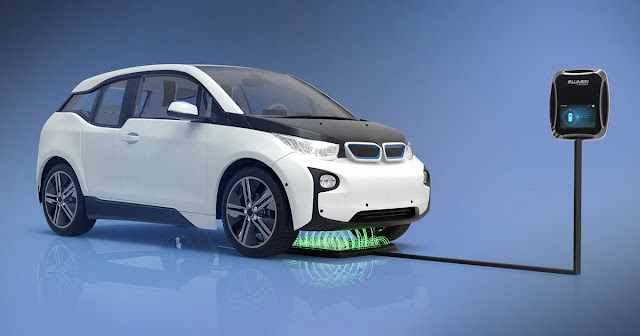The Future is Wireless Electric Vehicle Charging: How Wireless Charging Will Revolutionize Electric Vehicle Infrastructure
 |
| Wireless Electric Vehicle Charging |
Introduction to Wireless Electric Vehicle Charging
Wireless charging technology allows electric vehicles
to charge without plugging in. A charging pad placed on the ground or floor
sends power through electromagnetic induction to charge the vehicle's battery.
This eliminates the need for cables and connectors, simplifying the charging
process.
How Wireless Charging Works
Wireless
Electric Vehicle Charging relies on inductive power transfer between
two induction coils - one located in the charging pad and another placed in the
vehicle. When the coils are aligned over each other, an alternating electric
current running through the transmitting coil creates an alternating magnetic
field. This induces an electric current in the receiving coil through
electromagnetic induction. The power transfer is contactless and wireless.
Benefits of Wireless Electric Vehicle Charging
Wireless charging provides several benefits over traditional plug-in charging
methods:
Convenience of "Plugless" Charging
Drivers do not need to get out of their vehicle and fumble with cables to start
charging. All they need to do is park over the charging pad and the vehicle
begins charging automatically. This makes the process as convenient as filling
a petrol tank.
Simplified Charging Infrastructure
Wireless chargers can be installed on roadsides, in parking spots, and
driveways without the hassle of wiring cables to each location. They
future-proof the infrastructure by avoiding costly upgrades as vehicle
technology advances. Standardized charging pads replace a confusing array of
connector types.
Increased Range Certainty
Drivers always start and end trips with a fully charged battery when wireless
chargers are installed at common destinations like workplaces and malls. This
eliminates "range anxiety" over finding charging stations.
Potential for Dynamic Charging
Advanced systems allow electric vehicles to charge even while in motion, such
as while driving over electrified road surfaces. This could eliminate the need
for battery size increases as technologies progress.
Challenges of Wireless Electric Vehicle Charging
While promising tremendous benefits, widespread adoption of wireless charging
also faces some challenges:
Higher Upfront Installation Costs
Installing the coils, control electronics, and other hardware required for
wireless charging pads is more expensive than cable-based charging stations
currently. Mass production needs to drive down costs.
Lower Power Transfer Efficiency
A certain percentage of the transmitted power is lost as heat during wireless
transfer rather than being delivered to the battery. Systems must achieve high
efficiency comparable to plug-in charging.
Standardization Hurdles
Agreeing on wireless charging standards between automakers, equipment
manufacturers, and other stakeholders takes time. Multiple competing standards
could fragment the market initially.
Foreign Object Detection
Wireless charging systems must ensure safety by detecting any foreign metals
between the coils and interrupting power transfer to avoid overheating. Strict
protocols are required.
Addressing the Challenges
Concerted research efforts are addressing these challenges to enable widespread
adoption of wireless EV charging:
Cost Reduction through Mass Production
As production scales up to meet rising demand, costs will fall significantly
due to material efficiencies and automation. Mass deployment also attracts more
entrants to the market.
Advancing Power Transfer Technology
Latest coil and electronic designs coupled with new materials push efficiency
close to 100%.Advanced beamforming techniques enable targeted power focusing.
Global Standardization
The CharIn consortium is driving standardization with the Combined Charging
System standard. Regional alliances are also aligning on common voltage and
communication protocols.
Strict Safety Certification
Regulations ensure rigorous safety testing and certification processes for
wireless chargers before deployment. Systems automatically shut off power
transfer if foreign objects are detected.
Future Potential of Wireless Charging
Looking ahead, wireless charging promises to completely transform electric
vehicle infrastructure and the driving experience:
- Integration into roads and highways allows non-stop dynamic charging while
driving.
- Standardized contactless charging becomes ubiquitous at parking lots,
curbsides, bus/taxi stands and driveways.
- Municipal fleets like buses and taxis switch entirely to opportunistic
inductive chargers for maximum uptime.
- Automakers design electric vehicles around wireless compatibility from the
start.
- Behind-the-scenes wireless charger installations become invisible akin to
ubiquitous wifi.
- Electric mobility achieves true freedom and convenience unleashed by
omnipresent wireless power.
With a coordinated push towards development and standardization, wireless
charging has the potential in this new decade to surmount technical challenges
and cost barriers to finally emerge as the universal solution for electric
vehicle infrastructure. It promises to eliminate all range and charging
accessibility concerns to accelerate global transportation electrification. The
future of mobility is truly wireless.
Get
more insights on this topic: Wireless
Electric Vehicle Charging



Comments
Post a Comment